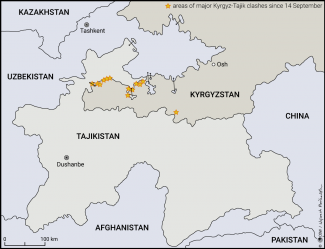Fighting on the Kyrgyz-Tajik border
Since 14 September, there have been fierce clashes between Kyrgyz and Tajik forces along almost the entire length of the border (excluding its eastern and high mountainous section). So far, a total of around 100 people are said to have been killed in the course of the fighting, which has been conducted using artillery, tanks, helicopters and UAVs (and other means) and around 140,000 civilians are said to have been evacuated on the Kyrgyz side. Both countries are holding each other responsible for the outbreak of fighting, although Bishkek’s version, accusing Tajikistan of aggression, seems far more credible. The clashes were not halted by appeals from the Russian president (he held telephone conversations with the presidents of both countries) or from the UN Secretary-General, nor by direct discussions between the leaders of the two countries during the Shanghai Cooperation Organisation (SCO) summit in Samarkand on 15–16 September.
Commentary
- Border tensions between Kyrgyzstan and Tajikistan are chronic and essentially the result of the lack of border delimitation and demarcation since the collapse of the USSR (1991). Over the years, the situation has been exacerbated by the rise of local problems – disputes over access to arable and grazing land and water sources amid worsening overpopulation in the disputed areas. In addition, the isolation of the region (poor transport links and remoteness from the centres – especially on the Kyrgyz side) and likely conflicts over control of smuggling routes all create scope for tension. A total of at least 50 people were killed in clashes analogous to the current ones in April last year. At the same time, both countries remain allies within the Russian-dominated Collective Security Treaty Organisation (each country also hosts Russian military bases), and are founding members of the SCO, which held a summit while the clashes were ongoing.
- The current escalation is taking place against a backdrop of growing problems – both internal and regional. Both countries face growing social challenges (reinforced by the economic troubles of Russia as a destination for mass labour migration), and each is strongly affected by regional instability, which has been exacerbated first by the Taliban takeover in Afghanistan and then by the consequences of the Russian invasion of Ukraine (disruption of the security system, Moscow’s focus on the West). There are political problems of the government in both countries. In Kyrgyzstan this refers to the relative weakness of the ruling system in Kyrgyzstan. In Tajikistan it is the tightening of the authoritarian course (the bloody pacification of Gorno-Badakhshan Autonomous Region in May of this year, the increasing repression of Muslims, Dushanbe’s involvement in intra-Afghan disputes and, above all, the succession of power process being prepared for the son of the incumbent president). In this situation, conflict with a neighbour is an attractive instrument of social consolidation. There is a lack of confirmed information on the reasons for the current outbreak, but both its conditions and its course indicate that it primarily serves Dushanbe’s interests.
- Although the intensity and external conditions of the fighting are unprecedented, in light of past experience, it is unlikely that it will rapidly transform into a full-scale conflict – neither country seems capable of doing so, and they are both also under pressure to end the fighting. However, neither the expected freezing of the clashes nor declarations that the process of delimiting and demarcating the borders will be sped up provide hope for a full resolution of the dispute and its removal from the intra-political agenda in the two countries.
- The Kyrgyz-Tajik conflict also remains an important test for Russia (the hitherto hegemon in the regional security sphere) and its methods of operating in an increasingly disadvantaged position (due to the problems in Ukraine), It is also a test for China, which is traditionally interested in the stability of its western borderland and being pushed against its will to play an active role in Central Asian security.
Map. Kyrgyzstan-Tajikistan borderland. Combat area as of mid-September 2022




